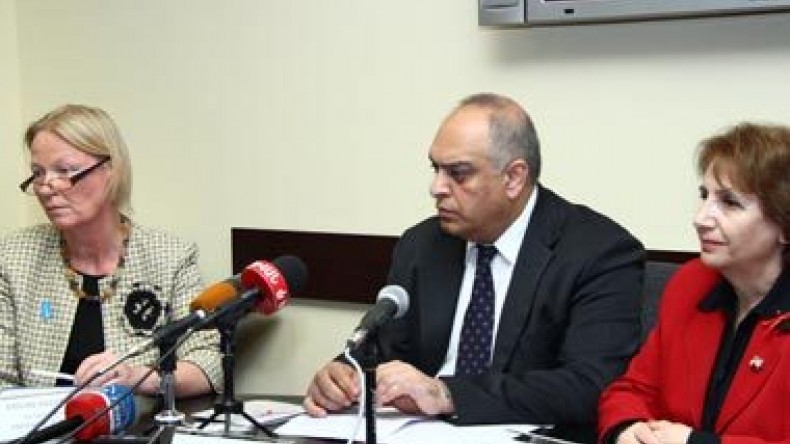
Investing in response essential to curb HIV transmission in Europe
New data for 2011 show that more than 121 000 new HIV cases were reported in the WHO European Region, including more than 28 000 in the European Union and the European Economic Area (EU/EEA). This indicates an increase for the Region from the previous year, which highlights the importance of sustaining interventions, even in times of economic austerity, to curb the continuing HIV transmission across Europe.
A new report by the European Centre for Disease Prevention and Control (ECDC) and the WHO Regional Office for Europe, released to mark World AIDS Day, indicates that, while the number of new HIV cases has fallen in many parts of the world, transmission shows no signs of a decline in the EU/EEA and is rising in eastern Europe and central Asia.
Further, continuing HIV outbreaks in some EU countries among people who inject drugs highlight that previously low numbers can rapidly rise in an outbreak when interventions are not sufficiently in place.
“The global financial crisis is challenging governments to invest in improved access to effective health interventions to prevent, test for and treat HIV/AIDS. Only one patient in four receives the needed antiretroviral treatment in the eastern part of the Region, one of the lowest rates in the world,” says Zsuzsanna Jakab, WHO Regional Director for Europe. “We urgently need to scale up resources, especially in eastern Europe and central Asia. Every euro spent now on HIV response will largely be paid back with savings on future treatment costs, not to mention the societal gains from keeping people healthy and productive.”
Speaking at a forum on public health in Athens, Greece on the eve of World AIDS Day, ECDC Director Marc Sprenger stressed: “Several recent examples from different EU countries show that failure to break the chain of HIV transmission will inevitably lead to high long-term HIV prevalence, particularly when we see from our data that 50% of the newly infected get tested late. If we want to reduce and prevent further transmission of HIV across Europe, we need to invest in and promote HIV counselling and testing. This way, we ensure early diagnosis, as well as access and adherence to treatment; decrease the number of late presenters; and improve the longer-term treatment outcomes for the individuals concerned.”
The new data show that over three quarters of the new HIV infections were reported from the eastern part of the European Region. Half of the newly diagnosed people in the Region learn of their HIV status late, when the benefits of treatment are reduced. Late diagnosis, along with low treatment coverage, results in increasing numbers of AIDS cases and deaths in eastern Europe and central Asia, which show no signs of stabilization or decline.
HIV is still highly concentrated in key populations, such as men who have sex with men, and people who inject drugs or come from countries with generalized HIV epidemics. Nevertheless, the new data indicate an increase in heterosexual transmission, now accounting for 50% of cases in the Region. Preventive interventions for couples in which one of the partners is engaged in high-risk behaviour should address the risk of heterosexual transmission.
The newly published surveillance report further supports the recommendations of WHO’s European Action Plan for HIV/AIDS 2012–2015, endorsed by all countries in the Region in 2011. It highlights the need to further promote HIV counselling and testing services throughout Europe to ensure that each and every person living with HIV is diagnosed and treated early. Action should particularly address key populations, and aim to reduce vulnerability and involve patients’ and civil-society organizations. This will result in improved treatment outcomes and clinical benefits, and help to prevent or reduce HIV transmission.
In the EU/EEA, HIV is highly concentrated in key populations, such as men who have sex with men, who account for the majority of cases, and people who originate from countries with generalized HIV epidemics or inject drugs. The number of HIV infections among people who inject drugs remained fairly low in 2011 (5% of HIV diagnoses), with a 40% decline since 2004.
During the forum on public health held in Athens on 30 November, ECDC presented an in-depth assessment of the HIV situation in Greece. It showed that a combination of factors may cause the current outbreak among people who inject drugs in Athens, one of the most important being long-term low levels of preventive services prior to the outbreak. ECDC urged that, in responding to the outbreak, the Greek authorities immediately prioritize interventions such as scaling up the coverage of opioid substitution treatment and needle and syringe programmes.
The number of AIDS cases has consistently declined in the EU/EEA since the mid-1990s.
World AIDS Day is celebrated on 1 December each year around the world. It has become one of the most widely recognized international health days and a key opportunity to raise awareness, commemorate those who have died, and celebrate victories such as increased access to treatment and prevention services.
The WHO European Region comprises 53 countries, with a population of nearly 900 million people, of which around 508 million live in the EU/EEA (27 EU Member States plus Iceland, Liechtenstein and Norway).
Newsfeed
Videos






























